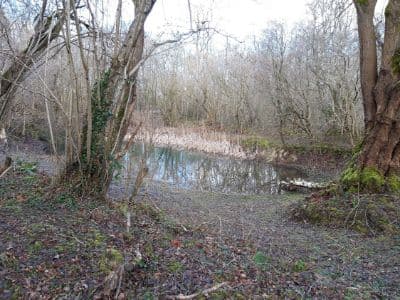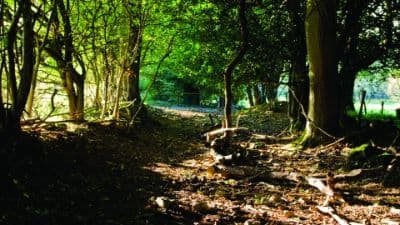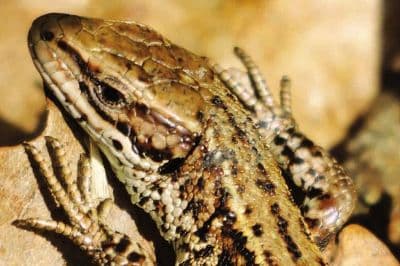Aberduna Nature Reserve – Flora and fauna abound on this hike around rocky outcrops, heathland and woods
This short walk visits the limestone ridge and beautiful woodlands of the Wildlife Trust’s Aberduna Nature Reserve and the open heaths and stunning views of Moel Findeg Local Nature Reserve managed by Denbighshire County Council.
Disclaimer
Our walks follow public footpaths as indicated on OS maps wherever possible.
You must read, understand and accept our disclaimer before you attempt any of our walks.
Walk details
1.8 miles (2.8 km) – two hours
OS Explorer Maps 256 and 265
Maeshafn is approximately four miles southwest of Mold. Park the car in the village centre near the telephone box (SJ 202 610) or at the small disused quarry just outside the village to the west (SJ 199 610).
There are some steep hills, steps, and difficult walking. Strong boots are recommended as areas can be wet in all seasons.
From the village green, with your back to the Old Chapel, turn right down the hill and head westwards towards Llanferres (and past the alternative quarry parking spot). Fork right along a track signposted Loggerheads and Aberduna just before the road goes steeply downhill.

Aberduna Nature Reserve
Fork right at the second waymarker post and follow the path to a kissing gate leading into Aberduna Nature Reserve. In July, look for orchids along the path; in autumn, the blackberries, rose hips and holly berries feed birds like the mistle thrush, blackbird, fieldfare and redwing. Follow the path through woodland, which is periodically coppiced to create glades.
Stop at a waymarker post (signposted Maeshafn) just before the main path goes downhill. Look here for a locally rare shrub, mountain currant (ribes alpinum) and, under the mature trees, a small patch of herb-paris indicating ancient woodland. Turn right towards Maeshafn. Watch out for long-tailed tits and greater spotted woodpeckers as well as more common species such as the blackbird and blue tit. Wind your way uphill through woodland up the steps to a kissing gate.
The Kissing Gate
Through the kissing gate there are fine views of Moel Famau, Moel Fenlli and the Alyn Valley. You are now in an area of calcareous grassland. On the limestone outcrops you will find cowslip, eyebright, common rock-rose, common spotted-orchid and bird’s-foot trefoil. Many butterflies can be seen in this area, including small heath, brown argus, common blue and small pearl-bordered fritillary. If you are here at dusk, you may see badgers hunting for food on the grassland. In autumn, the blackthorn scrub is heavily laden with sloes.
Turn left at a waymarker post indicating a viewpoint. Follow the path uphill to a kissing gate leading into a field. The short turf of this unimproved grassland is a fantastic place to see brightly coloured waxcap fungi in early autumn.

Turn right towards a waymarker post and follow the path to a further waymarker at the top of the hill. Continue to a partially concealed waymarker in an old gateway.
More Kissing Gates
Turn left to the waymarked viewpoint. These small field enclosures have been created by the exposed limestone pavement, populated in turn by hawthorn and blackthorn. Go downhill across a limestone rock outcrop, through a gap in an old dry-stone wall and across a field to a kissing gate. Follow the path to the left up to the Aberduna Quarry viewpoint where you can see fossil specimens.
Go through the kissing gate and keep right diagonally down across the field to another kissing gate onto a road. Turn right along this road. The hedgerows here are excellent for spring flowers of celandine, wild strawberry, wood sorrel, common dog-violet and herb-Robert.
Take the first left at Tŷ Newydd. This area is also known to have pied flycatchers during late spring and early summer. A little way up the road, turn right into Moel Findeg Local Nature Reserve. Follow the path signposted Moel Findeg uphill through the woodland.
The Pond

When the woods give way to heathland, turn right through a kissing gate on a small path before the main path goes steeply uphill. After a few paces, there is a pond on the left which is a good site for newts and dragonflies. Despite its altitude, the heath has lowland heath characteristics. The dominant flora consists of heather, bilberry, gorse, bracken and birch scrub. Follow the path across the heath, with extensive views of the Clwydian Range to the west. Pass through a kissing gate and go steeply downhill through birch woodland to another kissing gate leading onto a road.
Turn right onto the road and head back into the village of Maeshafn where your walk started.
Article and photographs kindly provided by Mark Roberts of the North Wales Wildlife Trust. Become a member or sign up for their monthly newsletter at northwaleswildlifetrust.org.uk.

